Flying Colors
July 15, 2020



 SCA Articles
SCA Articles
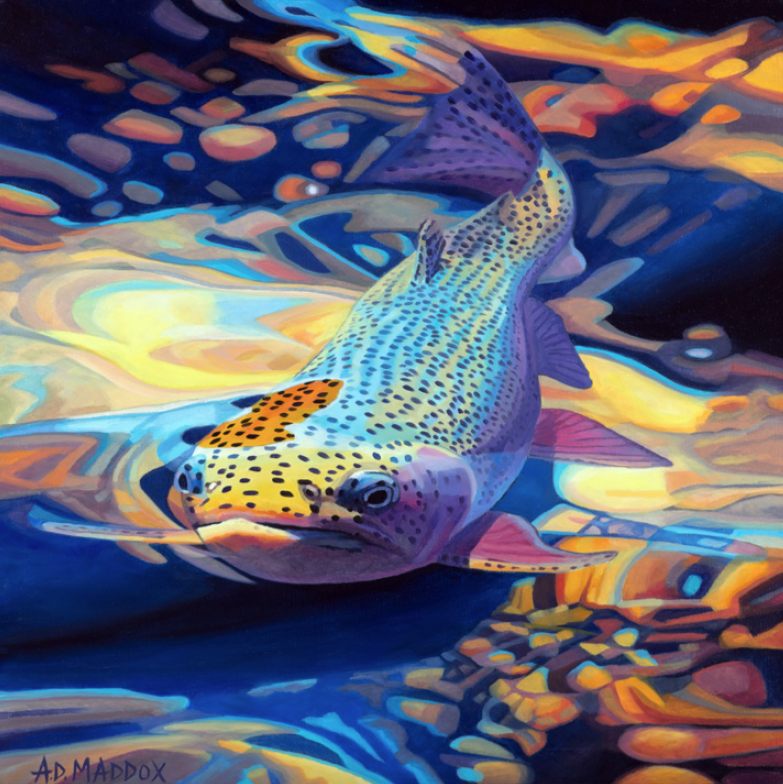
Defiant to those who say art must be pursued according to a rigid set of rules, AD Maddox is catching widespread acclaim for her colorful images of trout.
To encounter AD Maddox’s school of trout up close, you quickly realize why she lives up to her reputation as an artistic tour de force. But more importantly, to meet the painter herself firsthand, it also becomes abundantly clear why she is, by personality, nothing less than an unstoppable force of nature.
On a summer day we rendezvous at her new gallery in Livingston, Montana, one of the trout fishing meccas of the American West. Miss Maddox’s latest scenes, which hang on interfacing walls, literally bombard the senses.
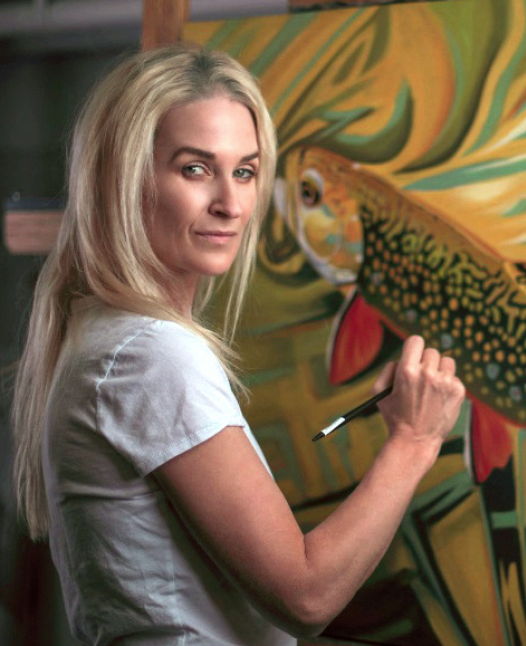
Before us hovers a monumental-sized Pop Art depiction of a rainbow trout soon to find residence in a young multimillionaire’s great room; nearby, a series of smaller works explore the abstracted patterns of different fish species; and not far away are piscatorial portraits mesmerizing in their translations of water, shadow and light.
Equally conspicuous, however, are numerous blank spots indicating where other paintings used to be. That’s because just the day before, within hours of opening her gallery near the corner of B and Callender streets, Maddox watched 10 of her original canvasses quickly sell. Catch and release, she was reminded again, applies to fish, not art.
Maddox admits that since resettling back in the northern Rockies, where with news of her arrival spreading by word of mouth, she has struggled to keep up with demand as art-collecting anglers from around the world pour into this town to pursue Yellowstone River rainbows, browns and cutthroats.
Some admirers were so instantly awestruck they bought major works on the spot—even as they were heading out to wet their lines on the river.
“I feel like Livingston is where I’m supposed to be,” Maddox says. “Everything I’ve been working toward has led me to this place at this moment in time.”
Nearing the mid-century mark in age, yet easily mistaken for someone much younger, Maddox is in the prime of her career, and there’s a buzz surrounding her evolving portfolio. While younger people may have little interest in the wildlife prints their elders purchased at DU and TU fundraisers decades ago, or even of inheriting a masterwork by a long-deceased sporting artist, they see in Maddox’s work a dynamic vitality that speaks to them in this century.
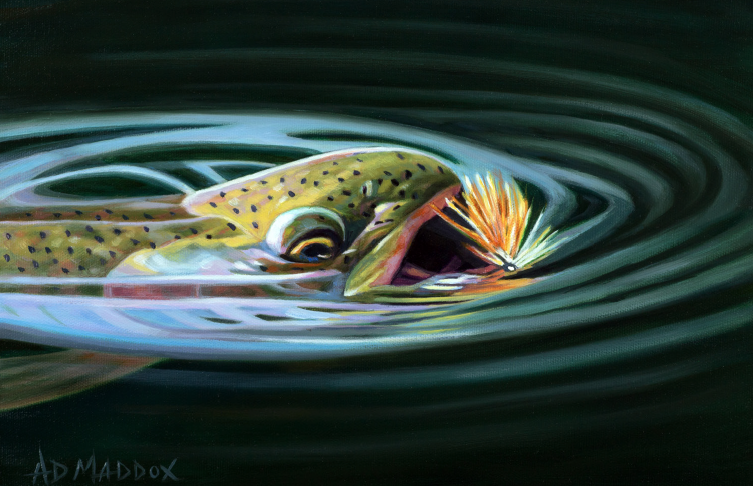
“If not completely on her own, then within a very narrow kind of movement in the sport, AD Maddox has brought to life an entirely new style of fishing art, a kind of photo-realism on steroids,” says Marshall Cutchin, a former longtime fishing guide in Key West, Florida, who now lives in Fort Collins, Colorado.
Cutchin publishes the online fly-fishing lifestyle magazine, MidCurrent, and every time he shares a new Maddox work, the reaction is off the charts.
“AD’s approach has since influenced many other artists, photographers and filmmakers,” says Cutchin. “And remarkably, her style continues to expand—always a step or two ahead of what could be expected.”
In addition to having her work featured on the covers of publications ranging from Gray’s Sporting Journal to L.L. Bean’s widely circulated catalog, and adorning the hulls of StealthCraft boats and products sold by Montana Fishing Company, Patagonia used AD’s images for their World Trout t-shirts. You can also buy floor rugs and print reproductions of Maddox paintings, whisky flasks, coffee mugs and greeting cards with her designs.
Even when she’s casting or shooting clay pigeons, AD does it with style, though these days she’s also apt to navigate the whirlwind of rising fame by unwinding on the back of a classic Ducatti 999 motorcyle. In Montana, where there’s a liberal speed limit on the interstates and rural backroads, she savors the liberating feel of her platinum-blond locks blowing out the back of her helmet, the sweet ambiance and scents of nature inundating her as she reaches warp drive. Maddox’s effusive enthusiasm for the outdoors is both genuine and infectious; so, too, her art.
Born Amelia Drane Maddox in Nashville, Tennessee, those who knew her in her childhood say she was regarded as something of an art prodigy by her grade-school teachers, demonstrating an innate ability to draw animals, birds in graphite and colored pencil after seeing them in the pages of nature magazines.
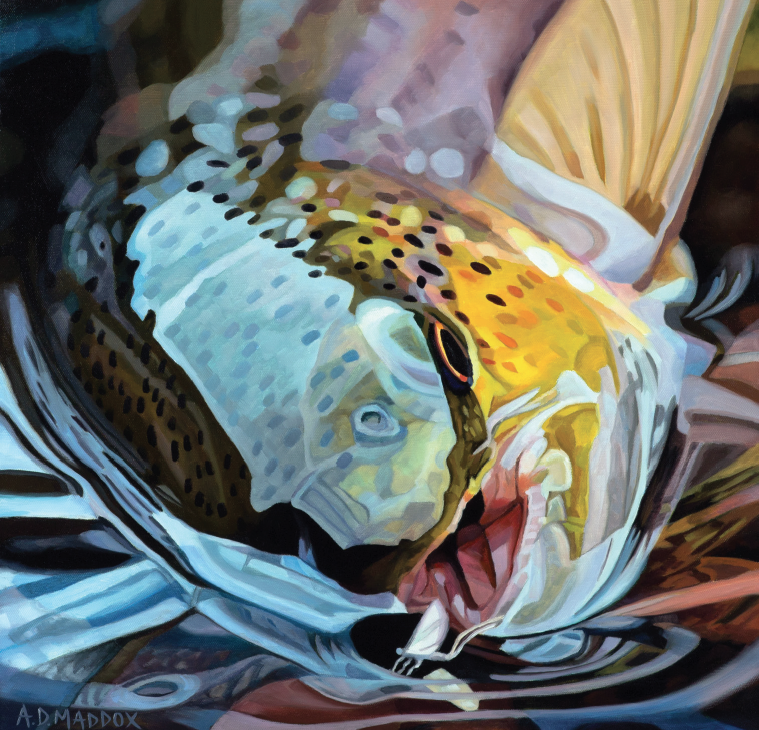
Hunting and fishing are engrained in her DNA. Her grandfather, Dan, was a renowned safari hunter and won prestigious awards from the Weatherby Foundation. Her father, Jim (known to many readers here for his involvement with Shikar Safari Club International) advised her not to attain an art degree in college because he believed she would have a difficult time making a living. Ironically, the advice turned out to be brilliantly prescient but not for the reasons her dad intended.
As Maddox explains, formal training can be a tricky thing. Yes, it can lay the groundwork of valuable knowledge about the elementals of color theory and composition, but structure, rigidly imposed, can also break an artist’s free spirit, especially those, like Maddox, guided by their own inner compass.
The reason Maddox paints like no one else is because she was never taught to emulate anyone else. Early in her life, she apprenticed under Flournoy Holmes and Kamy Deljou of Deljou Art Group in Atlanta.
But drawn to the West, Maddox left the Big Peach and Music City, moving to Jackson Hole, where she first learned to downhill ski as a 10-year-old. She lived near the foot of the Tetons for nearly 20 years. While her parents have means, they didn’t want her to be spoiled, insisting she learn how to exist on her own. She did, however, bring along her Ducati, which, at one point, served as a second easel.
Maddox’ big break in art is not unlike the almost mythic tales of actors and models being discovered at coffee shops. One day she walked into Center Street Gallery in Jackson, Wyoming, and had a conversation with its owner, Beth Overcast, who had seen flourishes of Maddox’ talent in decorative chairs and furniture she’d painted. Overcast offered to show a painted trout cabinet and, within 20 minutes of its arrival, the piece sold for $1,000. Based on that reception alone, Overcast gave Maddox an advance to deliver more trout portraits and from there, things started to snowball.
In Jackson Hole, she received mentorship from the late talented wildlife artist Greg McHuron, who gave her a deep introduction to plein air painting and responding directly to nature in the outdoors. From McHuron’s tutelage, she came to more fully understand the complicated relationships involving palette choices, tonality and value.
Eventually, she went back to Nashville and immersed herself in the studio, free of distractions, her compositions and explorations of light and color becoming more sophisticated. As this was happening, she grew homesick for the West. Her father had purchased a home up Tom Miner Basin near the wild back doorstep of Yellowstone National Park.
The Yellowstone River is the water corridor where Maddox first learned to cast a fly and where her family owns a second home high in the rugged foothills of the Gallatin Mountains, which are home to roaming grizzlies and wolves.

“I’ve always fished since I was a little girl, but it wasn’t until I reached 30 that I was given a fly rod from my dad and I made my first cast in Montana,” she says, noting that she became hooked by the mountainous surroundings of the Northern Rockies, mesmerized by the hueful patterns of different trout species. Once pulled from the water, their luster quickly fades, one of the reasons why so many of Maddox’s scenes feature her subjects swimming.
“I’m exploring other subjects, but I’ll never abandon trout,” she says, noting that wild trout populations in Montana are extensions of the landscape itself.
Livingston is legendary for attracting an eccentric group of characters—creative souls that have included hardcore sporting folk such as authors Thomas McGuane and Russell Chatham, actors Jeff Bridges and Peter Fonda, and the late Jim Harrison, William Hjortsberg and Richard Brautigan. She fits right in.
While it would be misleading to characterize Maddox as an iconoclast, she is ferociously strong-willed and independent, defiant to those who say art must be pursued according to a rigid set of rules. And it is this attitude that sets her free.
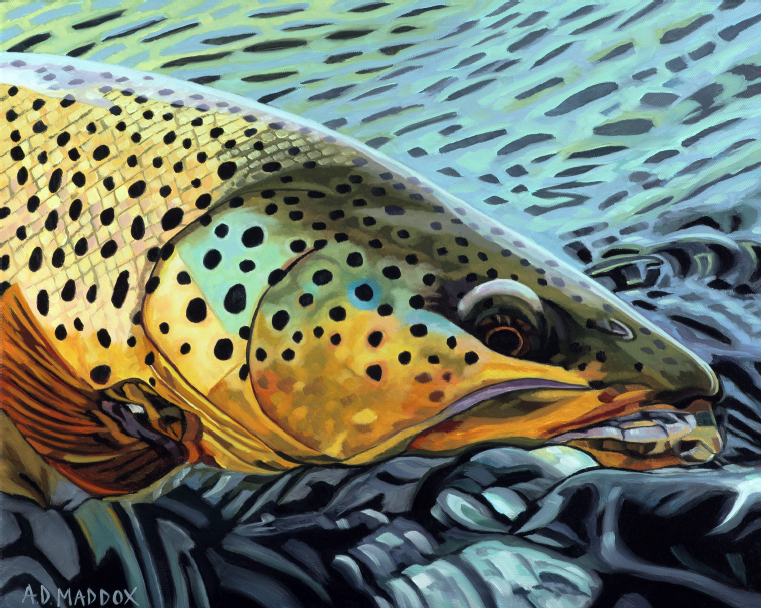
Impressionist Scott Christensen, an outdoorsman who is counted among the top American landscape painters and won the coveted Prix de West gold medal, has taken note of Maddox’s work.
“She has grown a lot in taking her designs to a whole new level,” said Christensen. “She’s paying attention to her edge work instead of being overly graphic. You can see the maturation that’s happening. AD Maddox is on a roll.”
